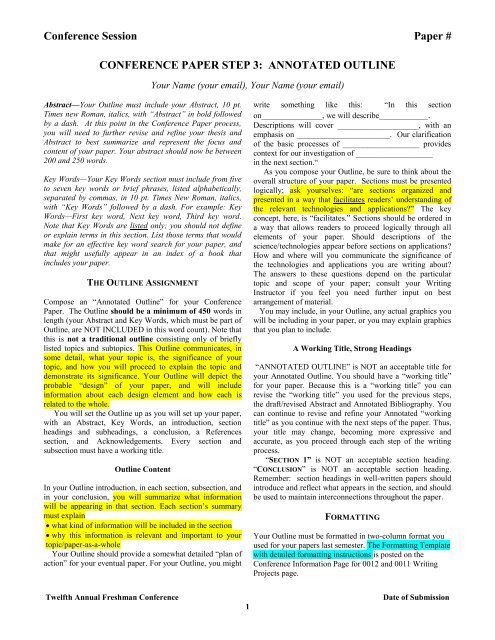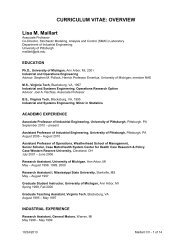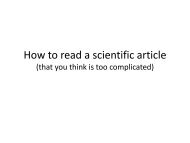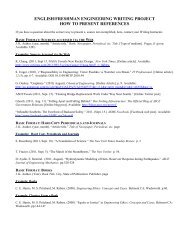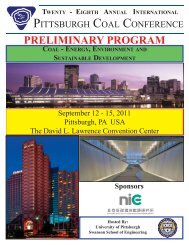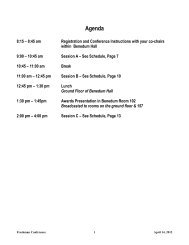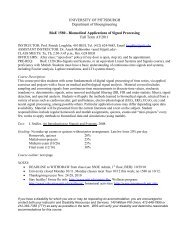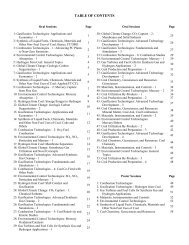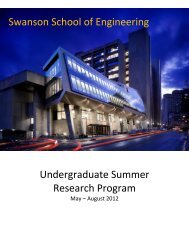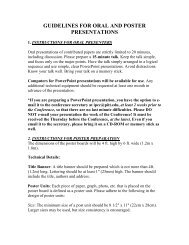Spring Conference Paper: Annotated Outline
Spring Conference Paper: Annotated Outline
Spring Conference Paper: Annotated Outline
Create successful ePaper yourself
Turn your PDF publications into a flip-book with our unique Google optimized e-Paper software.
<strong>Conference</strong> Session <strong>Paper</strong> #<br />
CONFERENCE PAPER STEP 3: ANNOTATED OUTLINE<br />
Your Name (your email), Your Name (your email)<br />
Abstract—Your <strong>Outline</strong> must include your Abstract, 10 pt.<br />
Times new Roman, italics, with “Abstract” in bold followed<br />
by a dash. At this point in the <strong>Conference</strong> <strong>Paper</strong> process,<br />
you will need to further revise and refine your thesis and<br />
Abstract to best summarize and represent the focus and<br />
content of your paper. Your abstract should now be between<br />
200 and 250 words.<br />
Key Words—Your Key Words section must include from five<br />
to seven key words or brief phrases, listed alphabetically,<br />
separated by commas, in 10 pt. Times New Roman, italics,<br />
with “Key Words” followed by a dash. For example: Key<br />
Words—First key word, Next key word, Third key word.<br />
Note that Key Words are listed only; you should not define<br />
or explain terms in this section. List those terms that would<br />
make for an effective key word search for your paper, and<br />
that might usefully appear in an index of a book that<br />
includes your paper.<br />
THE OUTLINE ASSIGNMENT<br />
Compose an “<strong>Annotated</strong> <strong>Outline</strong>” for your <strong>Conference</strong><br />
<strong>Paper</strong>. The <strong>Outline</strong> should be a minimum of 450 words in<br />
length (your Abstract and Key Words, which must be part of<br />
<strong>Outline</strong>, are NOT INCLUDED in this word count). Note that<br />
this is not a traditional outline consisting only of briefly<br />
listed topics and subtopics. This <strong>Outline</strong> communicates, in<br />
some detail, what your topic is, the significance of your<br />
topic, and how you will proceed to explain the topic and<br />
demonstrate its significance. Your <strong>Outline</strong> will depict the<br />
probable “design” of your paper, and will include<br />
information about each design element and how each is<br />
related to the whole.<br />
You will set the <strong>Outline</strong> up as you will set up your paper,<br />
with an Abstract, Key Words, an introduction, section<br />
headings and subheadings, a conclusion, a References<br />
section, and Acknowledgements. Every section and<br />
subsection must have a working title.<br />
<strong>Outline</strong> Content<br />
In your <strong>Outline</strong> introduction, in each section, subsection, and<br />
in your conclusion, you will summarize what information<br />
will be appearing in that section. Each section’s summary<br />
must explain<br />
what kind of information will be included in the section<br />
why this information is relevant and important to your<br />
topic/paper-as-a-whole<br />
Your <strong>Outline</strong> should provide a somewhat detailed “plan of<br />
action” for your eventual paper. For your <strong>Outline</strong>, you might<br />
write something like this: “In this section<br />
on_______________, we will describe____________.<br />
Descriptions will cover ____________________, with an<br />
emphasis on _______________________. Our clarification<br />
of the basic processes of ___________________ provides<br />
context for our investigation of ___________________<br />
in the next section.“<br />
As you compose your <strong>Outline</strong>, be sure to think about the<br />
overall structure of your paper. Sections must be presented<br />
logically; ask yourselves: “are sections organized and<br />
presented in a way that facilitates readers’ understanding of<br />
the relevant technologies and applications” The key<br />
concept, here, is “facilitates.” Sections should be ordered in<br />
a way that allows readers to proceed logically through all<br />
elements of your paper. Should descriptions of the<br />
science/technologies appear before sections on applications<br />
How and where will you communicate the significance of<br />
the technologies and applications you are writing about<br />
The answers to these questions depend on the particular<br />
topic and scope of your paper; consult your Writing<br />
Instructor if you feel you need further input on best<br />
arrangement of material.<br />
You may include, in your <strong>Outline</strong>, any actual graphics you<br />
will be including in your paper, or you may explain graphics<br />
that you plan to include.<br />
A Working Title, Strong Headings<br />
“ANNOTATED OUTLINE” is NOT an acceptable title for<br />
your <strong>Annotated</strong> <strong>Outline</strong>. You should have a “working title”<br />
for your paper. Because this is a “working title” you can<br />
revise the “working title” you used for the previous steps,<br />
the draft/revised Abstract and <strong>Annotated</strong> Bibliography. You<br />
can continue to revise and refine your <strong>Annotated</strong> “working<br />
title” as you continue with the next steps of the paper. Thus,<br />
your title may change, becoming more expressive and<br />
accurate, as you proceed through each step of the writing<br />
process.<br />
“SECTION 1” is NOT an acceptable section heading.<br />
“CONCLUSION” is NOT an acceptable section heading.<br />
Remember: section headings in well-written papers should<br />
introduce and reflect what appears in the section, and should<br />
be used to maintain interconnections throughout the paper.<br />
FORMATTING<br />
Your <strong>Outline</strong> must be formatted in two-column format you<br />
used for your papers last semester. The Formatting Template<br />
with detailed formatting instructions is posted on the<br />
<strong>Conference</strong> Information Page for 0012 and 0011 Writing<br />
Projects page.<br />
Twelfth Annual Freshman <strong>Conference</strong><br />
1<br />
Date of Submission
<strong>Conference</strong> Session <strong>Paper</strong> #<br />
NOTE: PASTE IN YOUR ANNOTATED<br />
BIBLIOGRAPHY<br />
Paste your <strong>Annotated</strong> Bibliography onto a separate page (or<br />
pages) after the end of your <strong>Outline</strong>. You do not need to<br />
revise or reformat your <strong>Annotated</strong> Bib., simply paste it in, as<br />
is.<br />
WHAT MUST THE REFERENCES AND ADDITIONAL<br />
RESOURCES SECTIONS INCLUDE<br />
Your References section must include full bibliographic<br />
information for any sources from which you quote,<br />
paraphrase, or summarize in your <strong>Outline</strong>. You must include<br />
these sources in your References section, even if they<br />
already appear in your “pasted in” <strong>Annotated</strong> Bibliography.<br />
Sources in your References Section should be listed in order<br />
of the corresponding bracketed in-text reference (always<br />
beginning with [1]—just as you listed them in your papers<br />
last semester. Remember: any graphics (charts, graphs,<br />
tables, photos, drawings) or equations taken from a source<br />
must be correctly referenced, in text and in your References<br />
section.<br />
Sources that you have consulted, but from which you<br />
have not quoted, paraphrased, or summarized must be<br />
included in an Additional Resources section. Again, you<br />
must include any sources used, even if they also appear in<br />
the “pasted in” <strong>Annotated</strong> Bibliography. You do not need<br />
“annotations” for sources in your <strong>Outline</strong>’s References and<br />
Additional Sources sections. Simply present the full<br />
bibliographic information according to the usual formatting<br />
specifications, found in the “Guide to Help You With<br />
Listing Your References Research Guide” on the 0012<br />
<strong>Conference</strong> Information page and the “Guide on How to<br />
Present References” on the 0011 Writing Projects page.<br />
Information in your Additional Resources section must be<br />
listed according to these same specifications, except in<br />
alphabetical order by the author’s last name, rather than by<br />
bracketed number.<br />
ACKNOWLEDGMENTS<br />
Your <strong>Outline</strong> must have an Acknowledgements section<br />
Twelfth Annual Freshman <strong>Conference</strong><br />
2<br />
Date of Submission
OUTLINE F.A.Q.<br />
Q. May we revise our <strong>Annotated</strong> Bibliography<br />
A. No, you may not revise your <strong>Annotated</strong> Bibliography; however, paying careful attention to your Writing Instructor’s<br />
comments on your Bib. will help you understand how to best continue to assess and use sources. The grade on your<br />
<strong>Annotated</strong> Bibliography will also help you see how well you are following instructions and attending to the (always<br />
important) details of an assignment. For example, if you did not include all required information in your<br />
“Annotations,” (and that information was required because it is important to you and your readers’ understanding of<br />
the value and purpose of a source), that missing information might be a sign that you need to give more careful<br />
attention to the details and examples of an assignment.<br />
Q. Should we revise our Abstract again Which version of our Abstract do we include in the <strong>Annotated</strong> <strong>Outline</strong><br />
A. Your <strong>Annotated</strong> <strong>Outline</strong> must have an Abstract. You will be revising your Abstract again, since you now have further<br />
feedback and experience regarding the best thesis and a prospective “plan of action” for your paper. Thus, your<br />
<strong>Annotated</strong> <strong>Outline</strong> will have your new, best-so-far Abstract, an Abstract that includes a clear, appropriate thesis and<br />
that summarizes how you will proceed through your paper. By the time you are completing your <strong>Annotated</strong> <strong>Outline</strong>,<br />
you will have a better idea of the topic of your paper and of how you will address all aspects of that topic. This<br />
improved understanding of the scope and content of your paper will allow you to write an Abstract that accurately<br />
states the topic of the paper and that accurately previews/summarizes what the paper will include.<br />
Q. How might this newest revised Abstract (the one we are including in our <strong>Annotated</strong> <strong>Outline</strong>) affect our grade<br />
A. A revised Abstract within your <strong>Outline</strong> will not alter the grade your received for your original Abstract or the<br />
revision<br />
of that Abstract (the revision included with your <strong>Annotated</strong> Bibliography). However, an excellent Abstract will<br />
contribute to and reflect excellence in your <strong>Outline</strong>, and so will contribute to a good grade on your <strong>Outline</strong>.<br />
Q. How should we use our <strong>Annotated</strong> Bibliography when composing our <strong>Outline</strong><br />
A. Your <strong>Annotated</strong> Bibliography and the continuing research you will be doing should help you know what sources and<br />
information you will be using for various sections, explanations, descriptions, and clarifications related to your topic.<br />
It will be useful to explicitly state, in your <strong>Outline</strong>, where (and how) you might include information from particular<br />
sources.<br />
Q. When we write our actual, full <strong>Conference</strong> <strong>Paper</strong>, will sections, headings, and content need to be exactly as they are in<br />
our <strong>Outline</strong><br />
A. The <strong>Outline</strong> should help you and your readers clearly see the focus and eventual content of your paper. You may<br />
continue to revise and refine focus and content as you continue with research and writing. While your <strong>Outline</strong> should<br />
demonstrate substantial work in all these areas, as you continue to investigate and understand your topic, it is entirely<br />
possible that you will add sections, add significant areas of information, rearrange the order of sections, change the<br />
titles of sections, etc., from <strong>Outline</strong> to <strong>Conference</strong> <strong>Paper</strong>.<br />
Q. Should our entire <strong>Annotated</strong> Bibliography appear in the <strong>Outline</strong> How should we handle references in our <strong>Outline</strong><br />
A. As noted in the <strong>Outline</strong> Assignment, you must include your <strong>Annotated</strong> Bibliography with your <strong>Outline</strong> submission.<br />
You do not need to reformat your <strong>Annotated</strong> Bib.—simply cut–and-paste it onto a separate page. If you have<br />
consulted new resources since submitting your <strong>Annotated</strong> Bib. you do not need to add these to your <strong>Annotated</strong> Bib.,<br />
but you do need to include these new resources in your <strong>Outline</strong>’s References or Additional Resources sections.<br />
A. Your References and Additional Resources sections, then, will include any sources from your<br />
<strong>Annotated</strong> Bib that you are continuing to use (though you will not include the description/annotation in your<br />
References or Additional Sources sections), plus any sources you are using that are “new”—that were not part of your<br />
<strong>Annotated</strong> Bib.<br />
A. Your REFERENCES section is the same kind of section you included in last semester’s papers. This section provides<br />
full bibliographic information for all in-text references. In-text references are accompanied by bracketed numbers,<br />
which correspond to the proper numbered references in your References section. Resources you have consulted, but<br />
from which you have not quoted, paraphrased, summarized, or used graphics or equations should appear in your<br />
Additional Resources section. Scroll down for the “How to Present References” document, also available via the 0012<br />
<strong>Conference</strong> Information site.
ENGLISH/FRESHMAN ENGINEERING WRITING PROJECT<br />
HOW TO PRESENT REFERENCES<br />
If you have a question about the correct way to present a source not exemplified, here, contact your Writing Instructor.<br />
BASIC FORMAT: SOURCES ACCESSED VIA THE WEB<br />
J. K. Author. (year, month). “Article title.” Book, Newspaper, Periodical, etc. Title. [Type of medium]. Pages, if given.<br />
Available: URL<br />
Examples: Sources Accessed via the Web<br />
K. Chang. (2011, Sept 15. NASA Unveils New Rocket Design. New York Times. [Online article]. Available:<br />
http://www.nytimes.com/2011/09/15/science/space/15nasa.html_r=1&hpw<br />
S. Unger. (2010, ).“Responsibility in Engineering: Victor Paschkis vs Wernher von Braun.” IT Professional. [Online article].<br />
12 (3), pp. 6-7. Available: DOI 10.1109/MITP.2010.94<br />
G. Ondrey. "Graphene." (2010, August). Chemical Engineering. [Online Article]. p. 9. Available:<br />
http://go.galegroup.com/ps/i.do&id=GALE%7CA235407371&v=2.1&u=upitt_main&it=r&p=AONE&sw=w<br />
ASCETweets (2011, Sept. 15). “Floating Bridge Replacement Work Under Way Near Seattle.” [Online Twitter post].<br />
Glynch. (2011, Aug. 11). “Falling Apart and Falling Behind.” Our Failing Infrastructure: The Official Blog of ASCE<br />
Government Relations.[Online blog post]. Available: http://blogs.asce.org/govrel/<br />
“Inflatable Seatbelts: The Forefront of Backseat Safety.” 2011, (Sept. 15.) ASME Facebook. [Facebook wall post]. Available:<br />
http://www.facebook.com/ASME.orgsk=wall<br />
BASIC FORMAT: HARD COPY PERIODICALS AND JOURNALS<br />
J. K. Author. (year, month). “Article title.” Title of Newspaper, Periodical, etc. page<br />
Examples: Hard Copy Periodicals and Journals<br />
S. Rosenberg (2011, Sept. 18). “A Foundation of Science.” The New York Times Sunday Review. p. 3<br />
T. Frazier. (2011, Sept. 5). “The March of the Strandbeests.” The New Yorker. p. 56.<br />
D. Aydin, E. Demirel. (2011, August). “Hydrodynamic Modeling of Dam‐ Reservoir Response during Earthquakes.” ASCE<br />
Journal of Engineering Mechanics. pp.528-528<br />
BASIC FORMAT: BOOKS<br />
J. K. Author. (Year). Book Title. City, State of Publication: Publisher. page<br />
Example: Books<br />
C. E. Harris, M .S. Pritchard, M. Rabins. (2008). Engineering Ethics: Concepts and Cases. Belmont CA: Wadsworth. p.60.<br />
Example: Chapter From a Book<br />
C. E. Harris, M .S. Pritchard, M. Rabins. (2008). “Equity or Justice” in Engineering Ethics: Concepts and Cases. Belmont CA:<br />
Wadsworth. pp.144-147
OTHER SOURCES<br />
Example: E-mail<br />
D. Budny. (2011, Sept. 21). [E-mail].<br />
Example: Conversation or Interview<br />
K. Bursic. (2011, Sept. 21). [Conversation]<br />
D. Robinson. (2011, Sept 22). [Interview]<br />
Example: Lecture<br />
L. Kogut. (2011, Sept 26). General Chem for Engineers 1. [Lecture]


